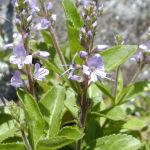| Common Name: |
Heath Speedwell |
| Other Names: |
Common Speedwell, Fluellen, Gypsyweed |
| Botanical Name: |
Veronica officinalis |
| Genus: |
Veronica |
| Family: |
Scrophulariaceae |
| Native Location: |
Europe |
| Cultivation: |
Dry, slightly acid soil in sun or partial shade. Prone to downy and powdery mildews. |
| Propagation: |
By seed sown in autumn; by division in spring or autumn; by semi-ripe cuttings in summer. |
| Harvest: |
Plants are cut when flowering and dried for infusions. |
| Height: |
10-50cm (4-20in) |
| Width: |
Indefinite |
| Hardiness: |
Z3-9 |
| Parts Used: |
Whole plant. |
| Properties: |
A bitter, astringent, alterative herb with a tea-like aroma when dried. It has weak diuretic and expectorant effects. |
| Medicinal Uses: |
Formerly, internally for bronchial, arthritic, rheumatic, and skin complaints, nervous exhaustion, and stomach upsets; externally for minor injuries. |
| Culinary Uses: |
Dried herb may be added to tea blends. |
| Bibliography: |
Encyclopedia of Herbs by Deni Brown Copyright © 1995, 2001 Dorling Kindersley Limited. pg 402 |

